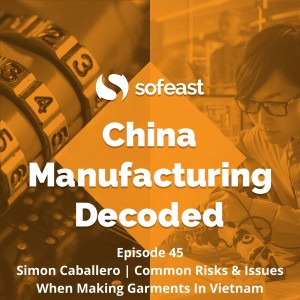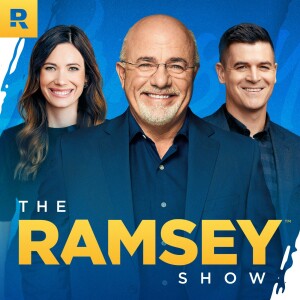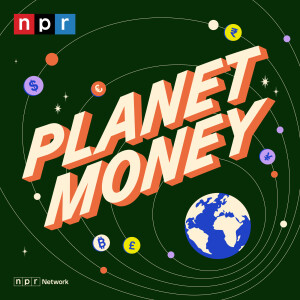

Simon Caballero | Common Risks & Issues When Making Garments In Vietnam
Renaud interviews Simon Caballero, a Hanoi-based purchasing manager and expert on manufacturing in Vietnam, to discuss the manufacturing industry in Vietnam, common risks and issues you will face when manufacturing garments there, and the relationship between developing new products and manufacturing in Vietnam and China.
Simon has a background in logistics and over a decade of experience in sourcing all kinds of products in Asia, with particular expertise in China and Vietnam (a growing manufacturing hub and popular alternative to China). In recent years he has been focused on the garment industry (specifically workwear), hence he's the authority to speak with for this episode's topic.
Show Notes
00:00 - Introducing the episode
00:54 - Brief self-introduction by Simon about himself and his experience - Simon explains how he started in Logistics in Spain, but since 2009 his journey has taken him to Thailand, China, and now, Vietnam.
04:53 - What is workwear (a particular focus of Simon's), and how has this clothing trend changed? - workwear includes protective clothing, technical garments, uniforms, and more. This kind of clothing has evolved to be more fashionable and specific to certain tasks and professions.
05:58 - Most factories in Vietnam can be categorized into one of three types (Simon believes this is common in garments and most other product types, too). What are they? - understanding the type of factories available is an important factor when choosing a Vietnamese garment manufacturing partner, so here they are:
- (07:05) Foreign-owned companies - these are growing fast and are mainly Korean, Chinese, Taiwanese, and Japanese invested businesses. They are more professional than local companies and have a stronger focus on QC and implementing modern production facilities and processes. But they are also more expensive, so they are a better choice for more complex and higher-quality products.
- (08:58) Locally-owned factories - usually only invest in the basics, such as production line/equipment, and lack an understanding of QC and technical processes. Can often specialize in one process or another, such as sewing, but they may not be able to handle multiple processes and sourcing - you can buy FOB from them, but you will need to support them in finding materials and accessories, for example. You need to manage your expectations well when working with them, but this is a low-cost option that can work well for less technical products.
- (15:49) State-owned companies - these are large well-financed companies that offer a vertically integrated service (so for garments this is materials, dying, weaving, etc). They are focused on medium/large buyers, so are not suitable for smaller buyers.
17:13 - The impact of Tet/Chinese New Year on obtaining materials and containers in the period just after the holiday in 2021 - raw materials and logistics have suffered from rapid price increases of 5-10% in 2021 after CNY/Tet. Simon discusses the reasons behind the increases, such as increased demand and speculators who had bought up materials when prices were low.
The lack of containers has also led to some delays in shipping from Vietnam, as well as logistics costs ballooning, too.
25:00 - The military coup in Myanmar has also affected garment production - unlike Vietnam, Myanmar was affected by COVID quite badly (with around 10 times as many deaths) and now the military coup there has also disrupted manufacturing. Simon got around this by quickly switching production from Myanmar to China.
26:01 - Are garments manufactured all around Vietnam as they are in China, or centralized in one area? - Vietnam has some industries that occur all around the country such as forestry product and chemical or mineral processing, but the country can be split into zones, each of which specializes in certain product types or materials:
- (27:02) The Far North (along the border with China & Laos) - more for natural resources and electricity, mechanical and agricultural industries, forestry, mining and minerals (specifically coal), less for assembly of electronics and garments, etc.
- (27:39) The North (around Hanoi & Haiphong) - industrialized provinces, especially for electronics and garments manufacturing, but also provides many of the natural resource industries found in the far North.
- (28:20) Central provinces (around Danang and along the coast) - specialize in textiles, footwear, and electronics assembly, also seafood, and agricultural processing.
- (28:51) The South (around Ho Chi Minh city) - specialize in high-quality textiles as that industry originated there in Vietnam, so they're the most experienced. Tends to be a higher cost than the North. Big brands are all manufacturing in the South in high quantities. More convenient for logistics, too. Also, electronics, software, and pharmaceuticals are found here.
30:41 - The differences between North & South Vietnam - like two different countries in some ways. The South is more open, developed, and more driven to do business, whereas the North is more traditional and led by the government as it is based there. Similarities in China are comparing the PRD cities in Guangdong with most other areas of China, where the latter have been exposed and doing business with foreigners for a long time and so are more open, experienced, and innovative. Also, Taiwan is more advanced again and can provide innovation that the Mainland doesn't have.
34:04 - How about developing new products in Vietnam? - Vietnam doesn't offer the diversity of products that China does, so for new product development in Vietnam, you need to consider that most materials, electronic components, injection molds, pharmaceutical chemicals, etc are imported from China. Importing to Vietnam increases costs and makes supply chains more vulnerable. It is feasible to develop new products in Vietnam, but it's likely there will be a strong reliance on China.
37:10 - QC in Vietnam - importers need to consider QC. Due to the small population in Vietnam in comparison with China, it can be harder to find qualified QC inspectors, and this shortage leads to higher travel costs and longer lead times for inspectors. There are also concerns over inspector integrity. The lack of QC inspectors can affect your new product development.
38:32 - Wrapping up
Related content...
- What Does Manufacturing In Vietnam Look Like Today In 2021? (a post on the blog from Simon)
- Setting up Manufacturing in Vietnam vs China: Focus on Vietnam
- Renaud has written a number of posts regarding Vietnam on QualityInspection.org
- Manufacture in China, Vietnam, India, or Elsewhere in 2021? (Podcast episode)
Remember, Sofeast provides most of our solutions in Vietnam, too, such as product inspections and factory audits, so if you are importing from Vietnam and need assistance, we can help. Visit our website at Sofeast.com.
Get in touch with us- Connect with us on LinkedIn
- Send us a tweet @sofeast
- Prefer Facebook? Check us out on FB
- Contact us via Sofeast's contact page
- Subscribe to our YouTube channel
There are more episodes to come, so remember to subscribe! You can do so in your favorite podcast apps here:
- Apple Podcasts
- Spotify
- Stitcher
- Google Podcasts
- TuneIn
- Deezer
- iHeartRADIO
Get in touch with us
-
- Connect with us on LinkedIn
- Contact us via Sofeast's contact page
- Subscribe to our YouTube channel
- Prefer Facebook? Check us out on FB
More Episodes
All Episodes>>Create Your Podcast In Minutes
- Full-featured podcast site
- Unlimited storage and bandwidth
- Comprehensive podcast stats
- Distribute to Apple Podcasts, Spotify, and more
- Make money with your podcast












